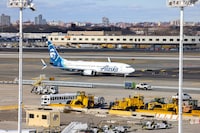In a recent development, the Federal Aviation Administration (FAA) has issued a safety recommendation urging airlines to conduct immediate inspections of the door plugs on Boeing’s 737-900ER model. This comes in the wake of a dramatic emergency landing caused by a blown-out door plug on another Boeing model. The FAA emphasized the need for airlines to ensure that the bolts on mid-cabin door plugs are adequately secured, citing it as an “added layer of safety.”
The specific concern revolves around the door plug design shared by the Boeing 737-900ER and the grounded 737 Max fleet. The recent incident involving an Alaska Airlines flight saw the door plug blowing out midflight, resulting in a gaping hole beside a row of seats. The plug fell thousands of feet into a backyard, prompting heightened scrutiny of Boeing’s aircraft safety measures.
Also read: Unveiling The Formative Years Of Donald Trump: A Revealing Look At His Time In Military School
Following the safety recommendation, airlines such as Delta Air Lines and United Airlines have committed to proactive inspections of their 737-900ER fleets. Both airlines have reassured passengers that these inspections will not disrupt flight schedules.
The FAA’s announcement highlighted that while the 737-900ER had previously logged over 11 million hours of operation and 3.9 million flight cycles without door plug issues, some operators had observed findings related to bolts during maintenance inspections.
Boeing, the leading aerospace manufacturer, has been under increasing scrutiny in recent months due to various reported flaws in its aircraft. These include loose bolts in the Max’s rudder-control system, drilling errors by a supplier, and a defect in the anti-icing system. The company is also facing legal action from passengers who experienced physical injuries and emotional trauma as a result of the blown-out door plug incident.
Also read; DeSantis Puts Majority Of His Focus On Iowa, Now Confronts Make Or Break Trial There
The legal complaint filed in a Seattle court detailed the harrowing experience of passengers, including the rapid depressurization that led to damage in multiple rows of the aircraft. The potential dangers of such an incident occurring at cruising altitude were also emphasized, with experts highlighting the risk of passengers being pulled out of the cabin in the event of a decompression.
The FAA’s proactive stance and the swift response from airlines to conduct inspections reflect a collective commitment to ensuring the safety and reliability of Boeing’s aircraft. As investigations continue into the underlying causes of these incidents, the aviation industry remains focused on upholding the highest standards of safety for passengers and crew.


